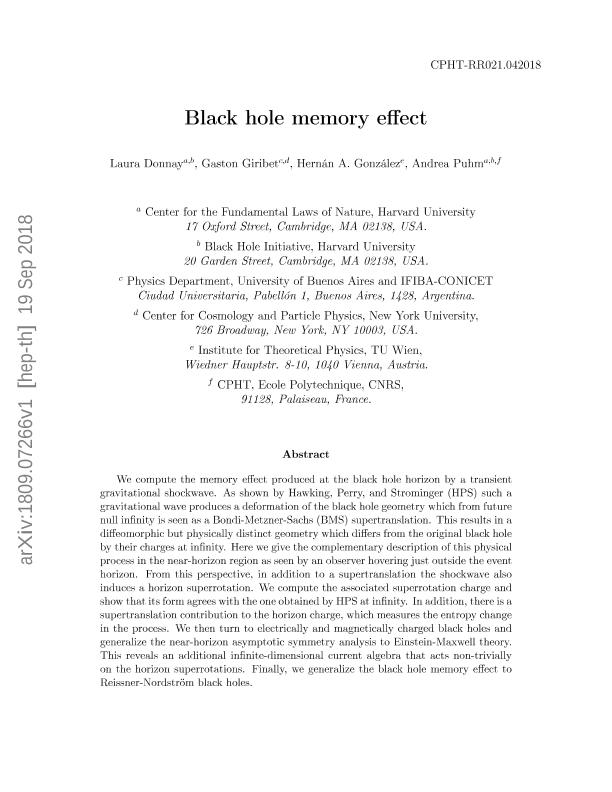Mostrar el registro sencillo del ítem
dc.contributor.author
Donnay, Laura
dc.contributor.author
Giribet, Gaston Enrique

dc.contributor.author
González, Hernán A.
dc.contributor.author
Puhm, Andrea
dc.date.available
2020-03-03T16:59:01Z
dc.date.issued
2018-12
dc.identifier.citation
Donnay, Laura; Giribet, Gaston Enrique; González, Hernán A.; Puhm, Andrea; Black hole memory effect; American Physical Society; Physical Review D: Particles, Fields, Gravitation and Cosmology; 98; 12; 12-2018; 1-22
dc.identifier.issn
2470-0029
dc.identifier.uri
http://hdl.handle.net/11336/98685
dc.description.abstract
We compute the memory effect produced at the black hole horizon by a transient gravitational shock wave. As shown by Hawking, Perry, and Strominger (HPS) such a gravitational wave produces a deformation of the black hole geometry which from future null infinity is seen as a Bondi-Metzner-Sachs supertranslation. This results in a diffeomorphic but physically distinct geometry which differs from the original black hole by their charges at infinity. Here we give the complementary description of this physical process in the near-horizon region as seen by an observer hovering just outside the event horizon. From this perspective, in addition to a supertranslation the shock wave also induces a horizon superrotation. We compute the associated superrotation charge and show that its form agrees with the one obtained by HPS at infinity. In addition, there is a supertranslation contribution to the horizon charge, which measures the entropy change in the process. We then turn to electrically and magnetically charged black holes and generalize the near-horizon asymptotic symmetry analysis to Einstein-Maxwell theory. This reveals an additional infinite-dimensional current algebra that acts nontrivially on the horizon superrotations. Finally, we generalize the black hole memory effect to Reissner-Nordström black holes.
dc.format
application/pdf
dc.language.iso
eng
dc.publisher
American Physical Society

dc.rights
info:eu-repo/semantics/openAccess
dc.rights.uri
https://creativecommons.org/licenses/by-nc-sa/2.5/ar/
dc.subject
Black holes
dc.subject
BMS
dc.subject.classification
Física de Partículas y Campos

dc.subject.classification
Ciencias Físicas

dc.subject.classification
CIENCIAS NATURALES Y EXACTAS

dc.title
Black hole memory effect
dc.type
info:eu-repo/semantics/article
dc.type
info:ar-repo/semantics/artículo
dc.type
info:eu-repo/semantics/publishedVersion
dc.date.updated
2019-10-22T18:02:07Z
dc.journal.volume
98
dc.journal.number
12
dc.journal.pagination
1-22
dc.journal.pais
Estados Unidos

dc.description.fil
Fil: Donnay, Laura. Harvard University; Estados Unidos
dc.description.fil
Fil: Giribet, Gaston Enrique. University of New York; Estados Unidos. Consejo Nacional de Investigaciones Científicas y Técnicas. Oficina de Coordinación Administrativa Ciudad Universitaria. Instituto de Física de Buenos Aires. Universidad de Buenos Aires. Facultad de Ciencias Exactas y Naturales. Instituto de Física de Buenos Aires; Argentina
dc.description.fil
Fil: González, Hernán A.. Vienna University of Technology; Austria
dc.description.fil
Fil: Puhm, Andrea. Harvard University; Estados Unidos. École Polytechnique; Francia
dc.journal.title
Physical Review D: Particles, Fields, Gravitation and Cosmology

dc.relation.alternativeid
info:eu-repo/semantics/altIdentifier/url/https://link.aps.org/doi/10.1103/PhysRevD.98.124016
dc.relation.alternativeid
info:eu-repo/semantics/altIdentifier/doi/http://dx.doi.org/10.1103/PhysRevD.98.124016
dc.relation.alternativeid
info:eu-repo/semantics/altIdentifier/url/https://arxiv.org/abs/1809.07266
Archivos asociados
